Taiwan's air defense system: medium-range and long-range anti-aircraft missile systems
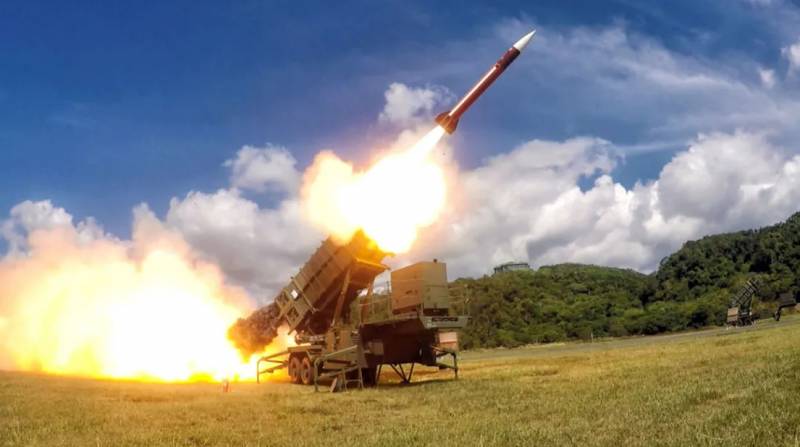
Taking into account the territory of Taiwan and the islands controlled by the Republic of China, this economically developed, but legally undefined state entity currently occupies one of the first places in terms of the deployment density of long-range air defense systems. As of 2015, 22 medium and long-range anti-aircraft missile systems were deployed in the territories controlled by Taipei.
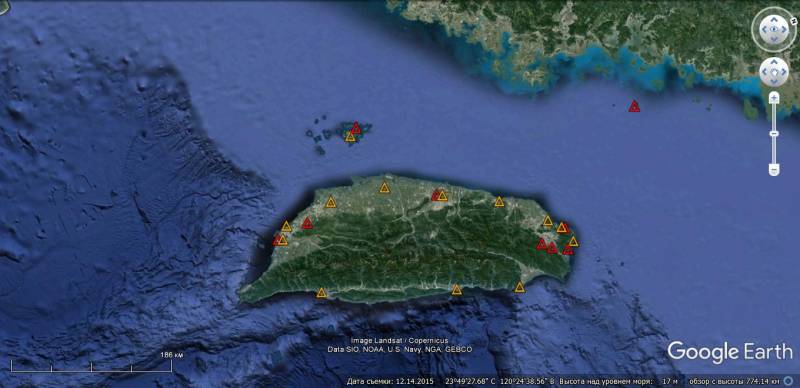
Scheme of placement of air defense systems of medium and long range in the territory of the Republic of China as of 2015
A fact little known to the general public is that in addition to purchasing air defense systems from the United States, Taiwan has successfully created and deployed its own long-range anti-aircraft missile systems. Thus, the rebellious island province of China is included in the elite club of countries that have the scientific, technological and industrial base necessary for the design and construction of modern air defense systems.
American-made medium and long-range anti-aircraft missile systems
The first air defense systems appeared in Taiwan in the early 1960s, when the United States, as part of a secret military operation, deployed equipment and personnel of the 2nd Battalion of the 71st Anti-Aircraft Regiment, equipped with long-range MIM-14 Nike Hercules systems, to the island as part of a secret military operation. Four anti-aircraft batteries were deployed along the northwest coast. The American crews were on combat duty for only a year, after which they left the island, handing over launchers, anti-aircraft missiles, radar, communications and other equipment to local military personnel who had received appropriate training.
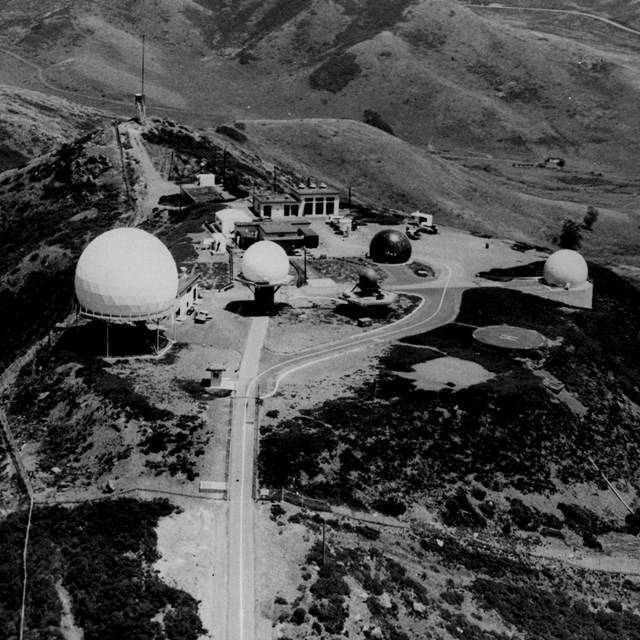
Radar early version SAM MIM-14 Nike Hercules
For its time, the MIM-14 Nike Hercules had very high performance and could hit air targets at a distance of up to 130 km, with a maximum altitude reach of 30 km. The big plus was that the complex used solid-fuel anti-aircraft missiles, which did not require dangerous and time-consuming refueling with toxic liquid fuel and an aggressive oxidizer that ignited combustible substances. In later versions, the firing range exceeded 150 km. But at a great distance from the tracking radar, the guidance error was too high, and an acceptable probability of hitting at such a range was provided only when using a “special” warhead. In the late 1960s, more than half of the MIM-14 missiles deployed on American soil were equipped with nuclear warheads. US allies were supplied with anti-aircraft missiles with conventional warheads.
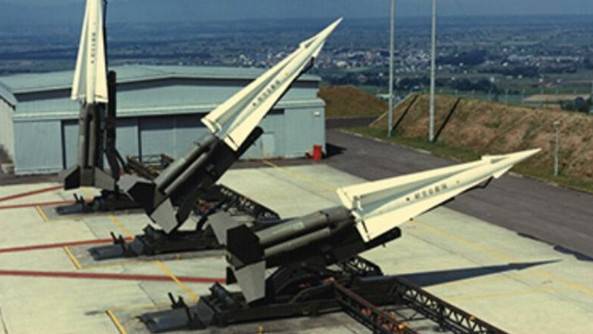
Anti-aircraft missiles SAM MIM-14 Nike Hercules on launchers
The first modifications of the Nike-Hercules complexes were actually stationary, their deployment and movement required considerable effort and a lot of time.
In the early 1970s, Taiwan bought four more MIM-14C Nike Hercules (Improved Hercules) batteries. The upgraded air defense system included new detection radars and improved tracking radars, which increased noise immunity and the ability to track high-speed targets.
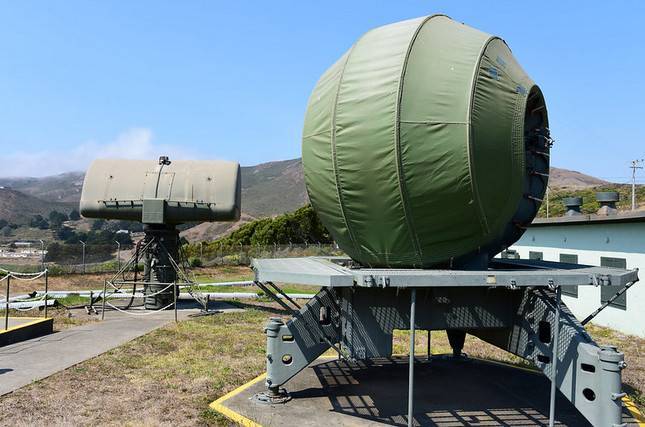
Radar facilities SAM MIM-14C
The use of an additional radio range finder made it possible to constantly determine the distance to the target and issue additional corrections for the calculating device. On the Improved Hercules variant, a significant part of the element base was transferred to solid-state electronics, which increased reliability, reduced the size and power consumption of the hardware. The upgraded air defense system could already be relocated to a new position within a reasonable time, and the mobility of the MIM-14C modifications was comparable to the mobility of the Soviet long-range S-200 complex.
At a distance of 120 km, a MIM-14S missile with radio command guidance in a simple jamming environment could intercept an N-0,5 (Tu-6) jet bomber flying at an altitude of 16 m with a probability of 10.
The service of the MIM-14С Nike Hercules air defense system in Taiwan continued until 1996. After that, these long-range complexes were replaced by the MIM-104 Patriot PAC-2 air defense system.
In the mid-1960s, the Republic of China Air Force (ROCAF) anti-aircraft missile forces received the MIM-23A Hawk air defense system. Unlike the actually stationary MIM-14 Nike Hercules air defense system, the Hawk complex with semi-active radar guidance could deal with high-speed targets operating at low altitudes. The advantages of the MIM-23A Hawk complex included: high noise immunity of the illumination and guidance radar, the ability to homing missiles to a source of interference, short reaction time, high mobility.
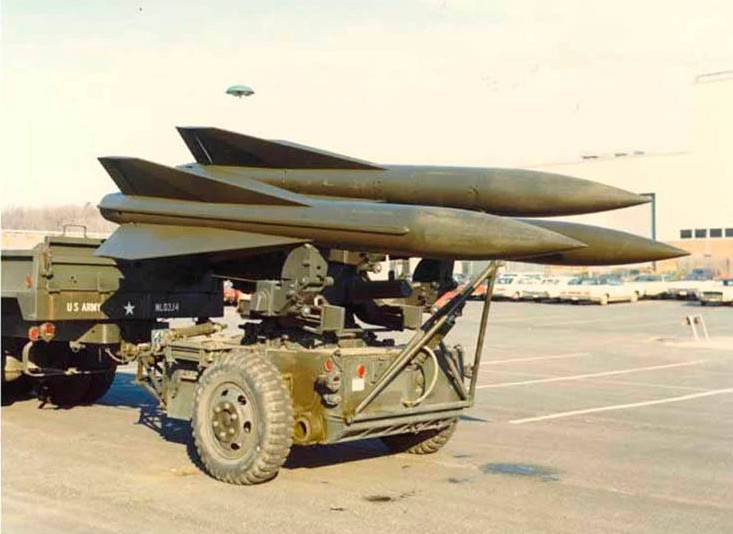
Launcher SAM MIM-23 Hawk
The missile, 5080 mm long and 370 mm in diameter, had a wingspan of 1210 mm and carried a fragmentation warhead weighing 54 kg. The minimum firing range was 2 km, the maximum - 25 km. The minimum height of the defeat is 60 m, the maximum height of the defeat is 11 m.
In total, the ROCAF received 13 Hawk batteries, which were upgraded to the MIM-1970B Improved Hawk level in the 23s. "Improved Hawk" could hit air targets at ranges from 1 to 40 km and in the altitude range of 0,03-18 km.
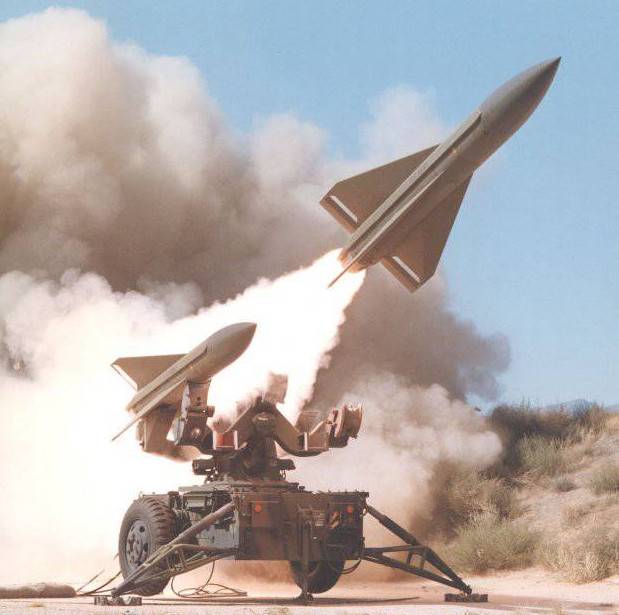
The main firing unit of the MIM-23V complex is a two-platoon anti-aircraft battery. The firing platoon had a radar station for target illumination, three launchers with three anti-aircraft guided missiles on each. In the first firing platoon there was a radar for illumination and guidance, an information processing point and a battery command post, and in the second there was a control post, a radar for illumination and guidance.
In the 21st century, the Improved Hawk air defense systems are gradually being phased out of service. Taiwan plans to completely phase out the Advanced Hawks in 2024.
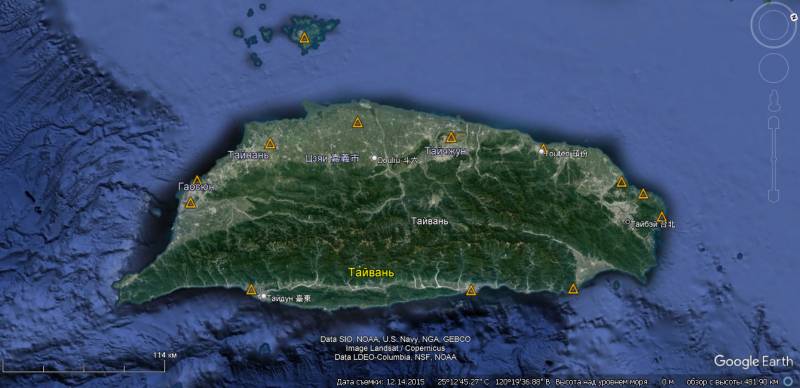
The layout of the MIM-23В air defense system in Taiwan as of 2015
At present, most of the American-made low-altitude air defense systems have been removed from their positions and are located at storage bases, which, apparently, is associated with the depletion of the hardware resource.
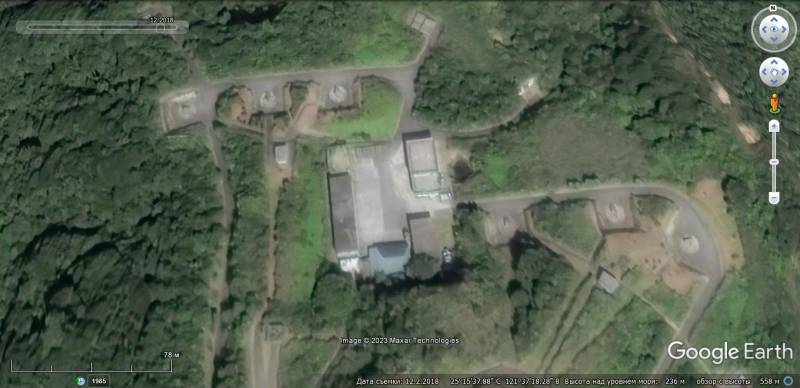
Satellite image of Google Earth: the position of the MIM-23В air defense system on the northern outskirts of Taipei
Nevertheless, part of the MIM-23В air defense system was retained in position. Publicly available satellite images show that Advanced Hoks are still in the vicinity of Taipei and cover approaches to large air bases.
In 1993, Taiwan entered into an agreement with the United States for the supply of three Patriot PAC-2 SAM batteries for MIM-104C anti-aircraft missiles. The total cost of the contract, taking into account the purchase of additional launchers, radar facilities and communications equipment, as well as the creation of a repair infrastructure and personnel training, amounted to $ 900 million. The contract was completed in 1996. Achieving full combat readiness occurred in 1998.
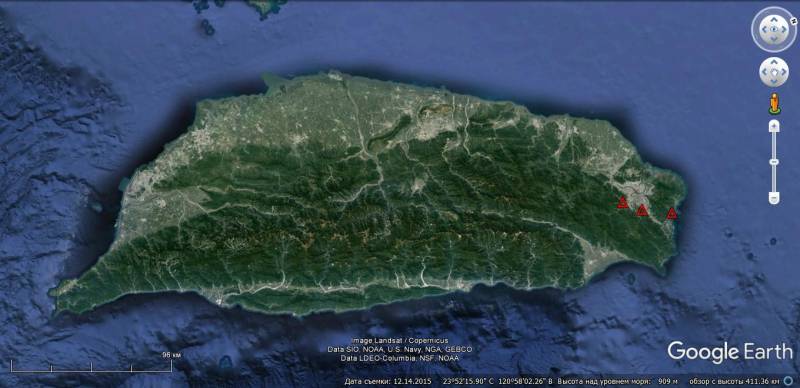
Scheme of the initial deployment of the Patriot PAC-2 air defense system in Taiwan
It was stated that the Patriots were intended to replace the obsolete MIM-14 Nike Hercules air defense systems, and all three Patriot PAC-2 batteries were deployed around Taipei.
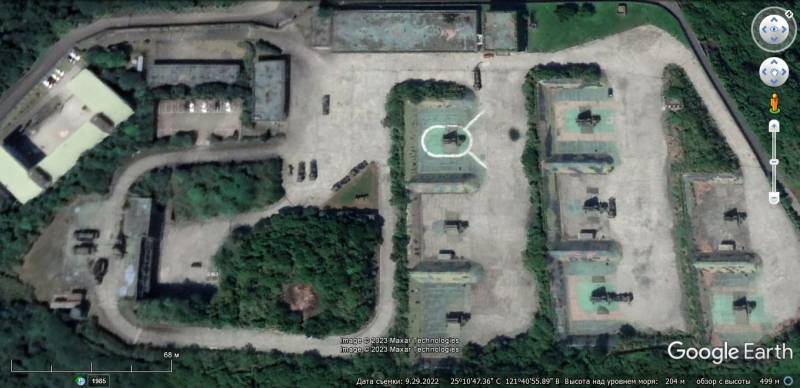
Satellite image of Google Earth: the position of the Patriot air defense system on the northern outskirts of Taipei
The PAC-2 Patriot air defense system includes: an AN / MPQ-53 multifunctional phased array radar, an AN / MSQ-104 fire control point, M901 launchers, MIM-104C anti-aircraft guided missiles, AN / MSQ-26 power supplies, means of communication, auxiliary equipment, means of radio engineering and visual camouflage.
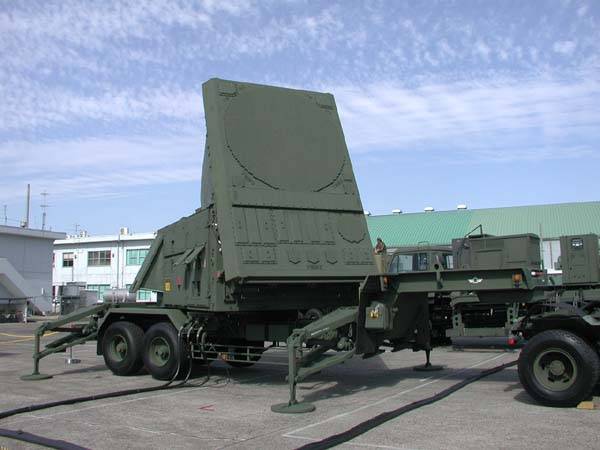
Multifunctional phased array radar station AN/MPQ-53
The AN/MPQ-53 multifunctional radar is mounted on a two-axle semi-trailer weighing 15 tons and is transported by a wheeled tractor. The operation of the radar is largely automated - it is served by two operators.
The station provides in a given sector the detection, identification and tracking of up to 125 air objects and flight control of anti-aircraft missiles. The maximum target detection range when viewed in elevation from 0 to 90 ° and in azimuth in the 90 ° sector is 35-50 km (with a target flight altitude of 50-100 m) and up to 170 km (1000-10 m). Such characteristics are achieved through the use of a phased antenna array and a high-speed computer that controls the operating modes of the station at all stages.
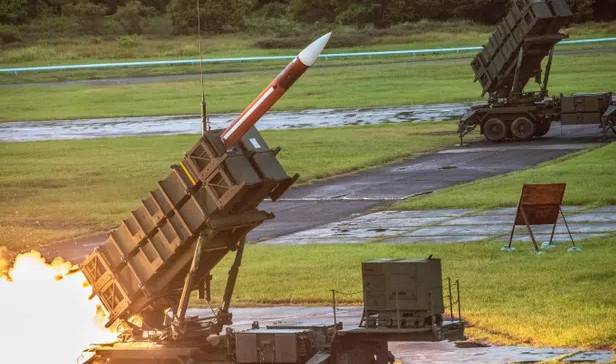
The flight control of the MIM-104C anti-aircraft missile is carried out using a combined guidance system. At the initial stage of the flight, software control is implemented, at the middle stage - radio command, at the final stage - radio command with sighting through the rocket (radio command guidance of the second kind).
In the process of pointing the missile at the target, the AN / MPQ-53 radar provides simultaneous target tracking and missile defense. The radar signals reflected from the target are received by the anti-aircraft missile equipment, and the angular coordinates of the target's line of sight determined by it are transmitted via the RF channel to a special radar antenna and fed to the computer of the fire control center. Also, the computer receives signals received by the radar directly from the target, which are compared with the signals from the missiles. Based on the analysis performed in the process of comparing these signals, guidance commands are generated for the missile and transmitted to it via the main beam of the radar. After conversion on board the SAM, these commands are transmitted to the rudder control drive, as well as to the anti-aircraft missile antenna drives to ensure continuous tracking of the target.
In Russian publications, the American Patriot PAC-2 air defense system, which used the MIM-104C missile defense system, is usually criticized for its low effectiveness against operational-tactical missiles. At the same time, the "critics" forget (and most likely do not know) that this complex was originally intended primarily for the destruction of aerodynamic targets (helicopters, aircraft and cruise missiles), and limited anti-missile capabilities are a nice additional option. In terms of its capabilities to combat air targets, the Patriot of this modification was fully consistent with its main purpose and, in terms of efficiency, is comparable to the Soviet S-300PS / PT-1 air defense systems with 5V55R missiles (firing range 75 km). The Soviet S-300PS / PT-1 systems, produced simultaneously with the Patriot PAC-2, were purely anti-aircraft and could not fight ballistic missiles. To cover the troops from the strikes of the TR and OTP, we created the S-300V air defense system. However, the start of mass production of the S-300V coincided with the collapse of the USSR, and all systems of this type produced can be counted on the fingers.
In connection with the strengthening of the combat capabilities of the PLA Air Force and the mass production of short-range and medium-range missiles in the PRC, the Taiwanese military at the beginning of the 21st century attended to the modernization of the Patriot air defense system and giving them expanded anti-missile capabilities.
In 2007, it was decided to upgrade the Taiwanese PAC-2 air defense systems to the PAC-3 level, for which $ 930 million was allocated. Already the following year, it was possible to obtain US consent to sell four additional batteries of the Patriot PAC-3 air defense systems and 330 anti-aircraft missiles. The deal amounted to $3,1 billion. The delivery of new anti-aircraft systems took place in 2013.
The Patriot PAC-3 air defense system can deal with aerodynamic targets at ranges up to 100 km and intercept operational-tactical ballistic missiles at a range of about 25 km.
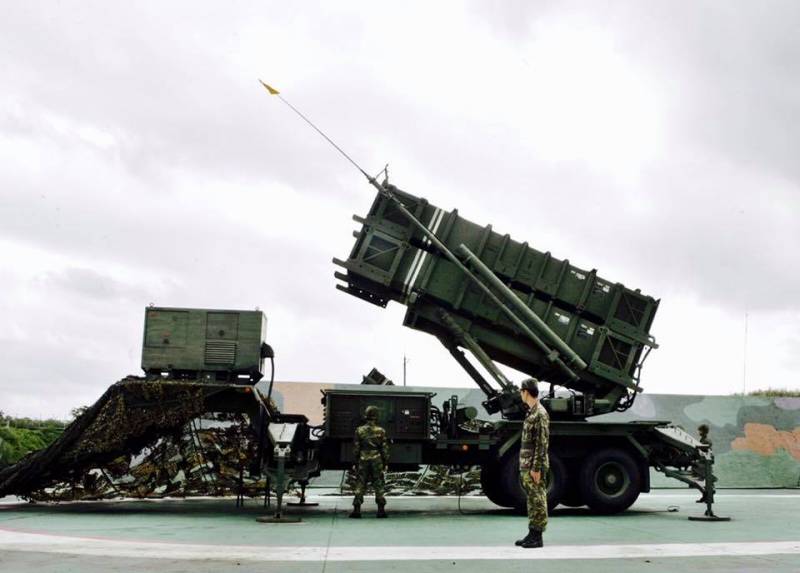
The Patriot PAC-3 air defense system includes: AN / MPQ-65A radar, AN / MSQ-132 command post (with a set of Link 16 equipment), towed launchers, MIM-104E Guidance Enhanced Missile-TBM anti-aircraft guided missiles (mainly to destroy air targets), Missile Segment Enhancement anti-missiles (improved MIM-104F), EPP III mobile power generators and mast-lifting devices.
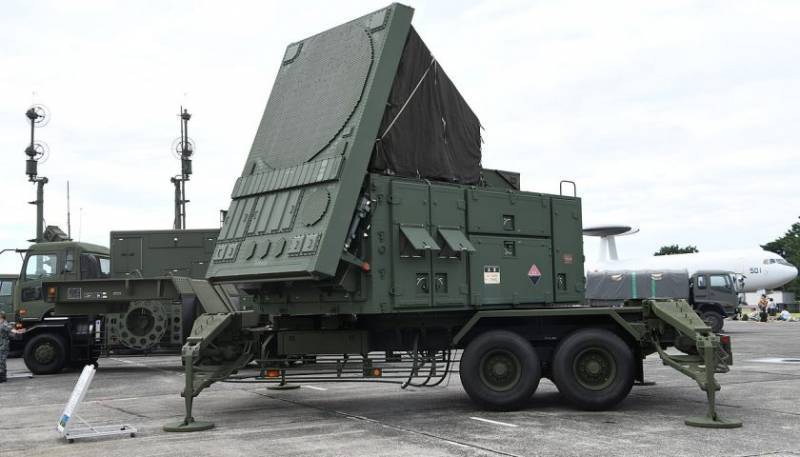
Multifunctional radar AN / MPQ-65A
To expand the ability to independently search for targets, anti-aircraft missile divisions can be attached to mobile surveillance radars of various types. For example, the AN / TPS-59 or AN / TPS-77 radars available in Taiwan (more here).
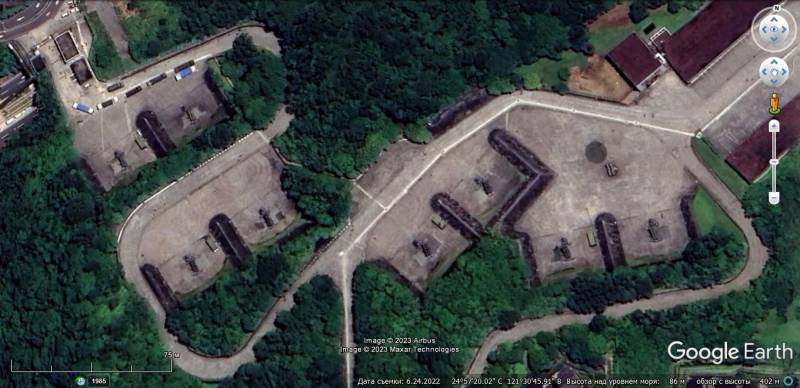
Satellite image of Google Earth: the position of the Patriot air defense system on the southern outskirts of Taipei
Currently, three Patriot batteries are on constant combat duty in the vicinity of Taipei. The rest of the existing complexes are periodically deployed in various parts of the island during regular exacerbations of relations with mainland China and for training purposes.
Apparently, the most recent American-made air defense systems, received 10 years ago, are considered as a strategic reserve and most of the time they are in highly protected shelters, which guarantees their survival in the event of a surprise strike from the PLA Air Force.
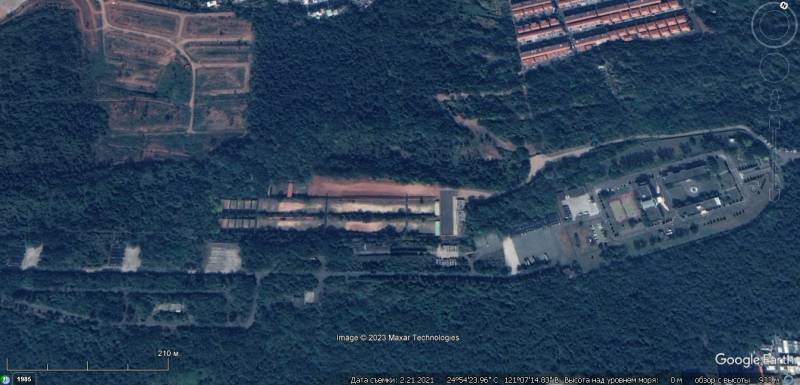
Satellite image of Google Earth: the former position of the MIM-14 Nike Hercules air defense system in the southwestern part of the city of Yangmei. The image, taken in 2021, shows that the buildings and structures of the missile base are in good condition, and there are military equipment in the parking lots.
Along the western coast of Taiwan and in its central part, there are well-equipped sites with caponiers and reinforced concrete structures, designed for the rapid deployment of anti-aircraft systems. Some of them are the former positions of the Nike-Hercules and Hawk air defense systems, but 5 reserve launch missile positions are equipped from scratch.
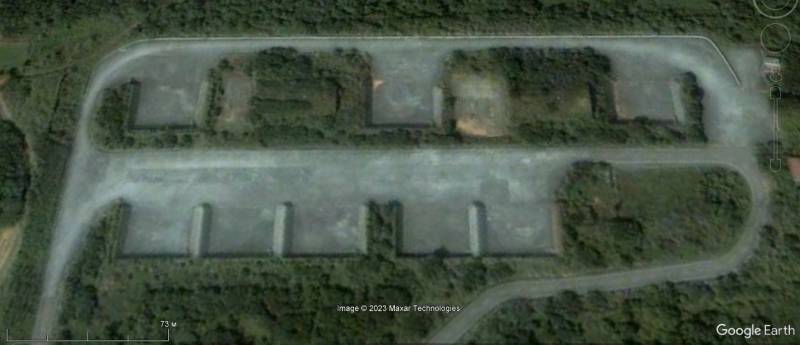
Satellite image of Google Earth: the reserve position of the Patriot air defense system on the coast, west of the city of Miaoli
In December 2022, it became known about the intention of the Republic of China to acquire an additional batch of Patriot PAC-3 MSE (Missile Segment Enhancement) air defense systems. We are talking about the supply of 114 anti-aircraft missiles, 3 AN / MPQ-65 radar sets, one AN / MSQ-133 information and coordination center, one tactical command post, three radio relay communication stations, three AN / MSQ-132 fire control points, 26 launchers M902 installations, 5 groups of antenna-mast devices, mobile diesel power plants, battery maintenance equipment, as well as tractors, communication equipment, tools, diagnostic equipment and spare parts. The estimated value of the contract is about $3 billion.
Long-range air defense systems made in Taiwan
After the establishment of diplomatic relations between Washington and Beijing, the government in Taipei came to the conclusion that it was necessary to reduce dependence on the United States in terms of arms supplies.
In this regard, in 1981, the creation of long-range air defense systems began in Taiwan. The development of a new "strategic" anti-aircraft complex was carried out by the Chungshan Institute of Science and Technology together with the American corporations Raytheon and Lockheed Martin. At the same time, the technical solutions implemented in the Patriot air defense system were used as part of the Taiwanese complex. The deployment of the complex, which received the designation Tien Kung, began in 1993.
The Tien Kung air defense system included semi-active radar-guided anti-aircraft missiles, a command post, a Chang Bei multifunctional radar, a CS / MPG-25 illumination and guidance radar, vehicles for transporting and loading missiles, an autonomous power supply power plant, and communications equipment.
The Chang Bai phased array radar, operating in the 2-4 GHz frequency range, is based on the Lockheed Martin ADAR-HP (Air Defense Array Radar-High Power) radar. The technical characteristics of this radar remain classified, but the declared detection range of a high-altitude target with an area of 1 m2 is about 400 km.
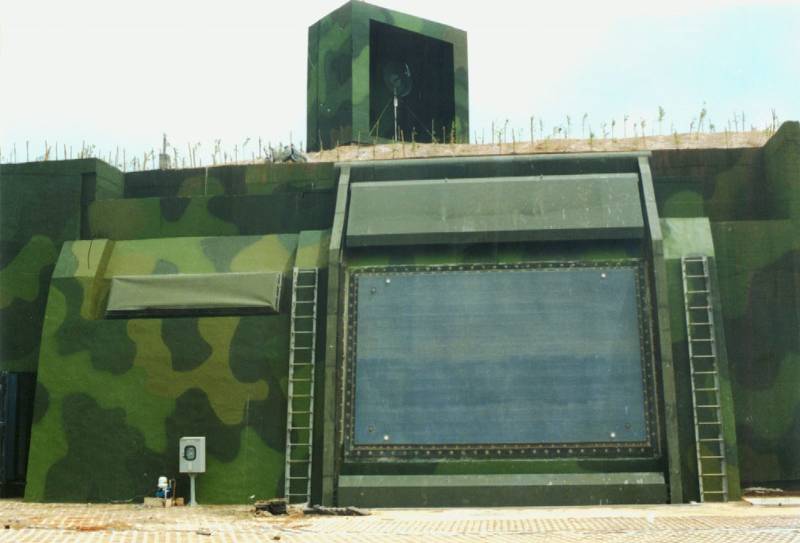
Below is the Chang Bei multifunctional radar, common to Tien Kung I and II, on top of the CS / MPG-25 illumination radar, necessary for targeting Tien Kung I missiles
The fixed antenna web provides coverage in a sector of 120°. The maximum range is more than 450 km. In the late 1990s, a mobile modification of the Chang Bai radar appeared, which, in addition to aerodynamic targets, is able to effectively work on ballistic missiles. At the moment, at least 7 such stations have been deployed.
The CS / MPG-25 target illumination radar operates in the 18-32 GHz frequency range and provides tracking of a target at a distance of about 200 km, the ceiling is more than 30 km. The CS / MPG-25 radar with a continuous-wave parabolic antenna is based on the AN / MPQ-46 radar used in the I-HAWK air defense system, but is approximately 60% more powerful.
The first modification of the Tien Kung complex was stationary. Vertically launched anti-aircraft missiles during combat duty were in silo launchers (which is not typical for air defense systems), and radar antennas and their hardware were placed in reinforced concrete structures. SAM launchers were carried from the radar part for several kilometers.
The solid-propellant anti-aircraft missile, outwardly similar to the American MIM-104, had a length of 5,4 m, a diameter of 0,41 m, and a mass of 915 kg. Flight speed - up to 4M. Range of defeat - up to 70 km. After launch, at the initial stage of the trajectory, inertial control was used, as it approached the target, the missile flight path was corrected using radio commands, when approaching the target, the CS / MPG-25 illumination radar was turned on, after which the semi-active radar seeker ensured guidance of the missile defense system on the signal reflected from the target .
In 1998, the Tien Kung II air defense system, created on the basis of the previous modification, entered the tests. The use of an anti-aircraft missile with an additional booster module and an increase in the operating time of the main engine made it possible to raise the maximum speed to 4,5M and bring the firing range to 150 km. At the same time, the SAM has become longer by 23 cm, and its starting weight is 1135 kg. Warhead weight - 90 kg.
Tien Kung II air defense missiles can be launched from both silos and towed launchers, which are similar in appearance to the American M902 launchers used as part of the Patriot PAC-3 air defense system.
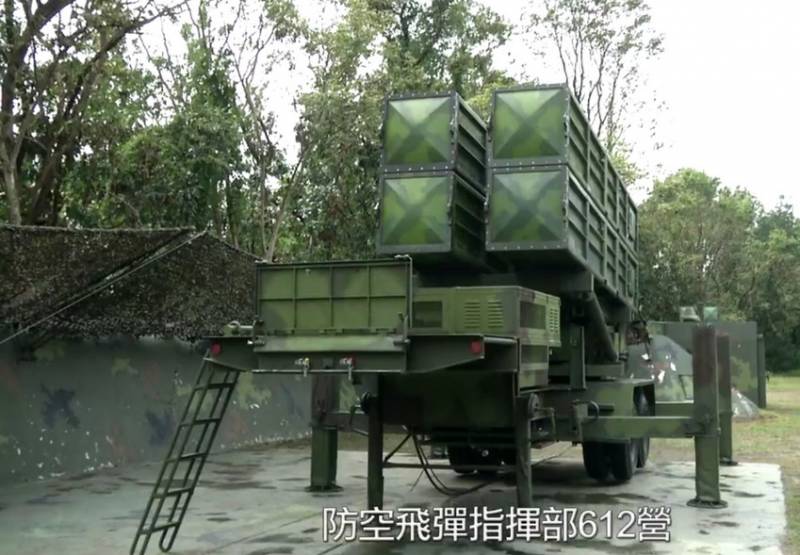
To aim at the target of the Tien Kung II SAM, an active radar seeker operating at frequencies of 28-32 GHz is switched on in the final section of the trajectory. At the initial stages of flight, inertial control and radio correction are used. Thanks to the use of a computer system similar to that used in the American Aegis CICS, it is possible to simultaneously fire a large number of targets.
Modification Tien Kung II is capable of hitting actively maneuvering air targets in the face of electronic countermeasures. It is reported that this complex has acquired anti-missile capabilities and can deal with OTPs with a launch range of up to 500 km.
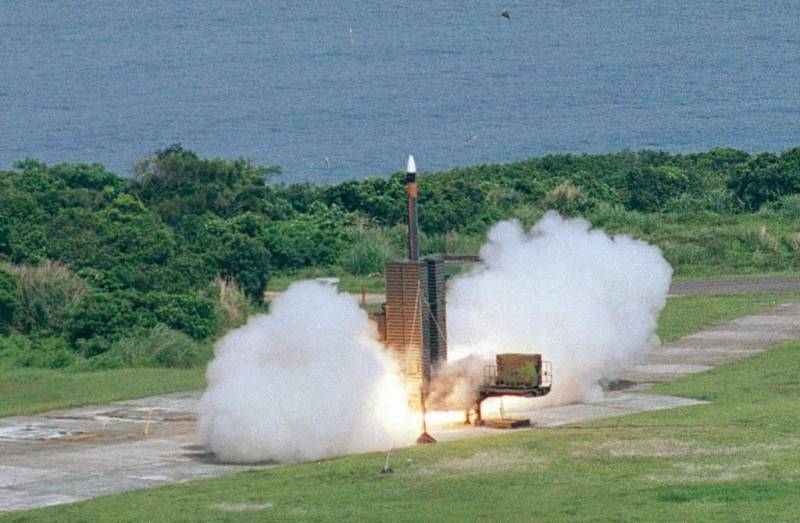
Judging by the available photographs, Tien-Kung II anti-aircraft missiles are capable of launching from a launcher oriented towards the target, or vertically. At the same time, the affected area of the complex is limited to the viewing sector of the Chang Bei radar.
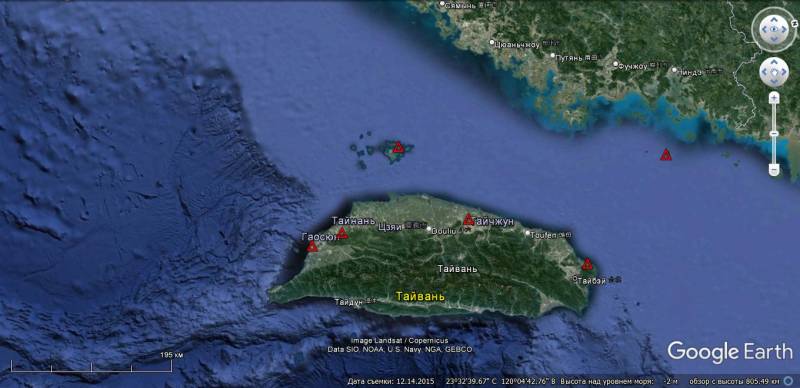
Tien Kung II air defense system layout
The coordinates of six positions of the Tien Kung II air defense system are known. Four of them are located on the territory of the island of Taiwan, one each on Penghu Island and Matsu Island.
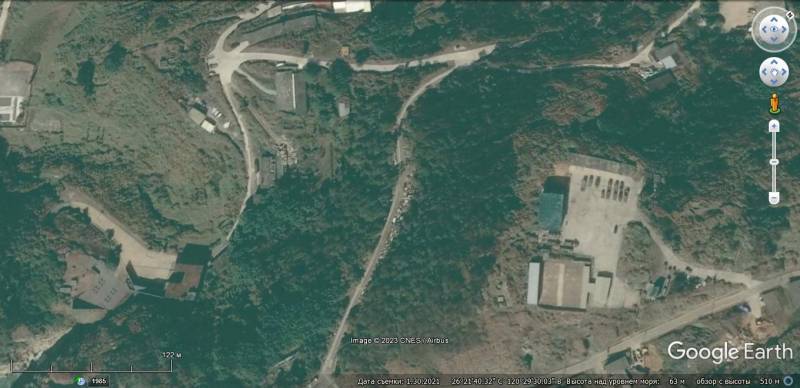
Satellite image of Google Earth: the position of the Tien Kung II air defense system on Matsu Island
At present, the Tien Kung II modification SAMs have completely replaced the early model missiles launched from silo launchers. SAMs removed from combat duty after re-equipment of the control system are used as targets simulating ballistic targets.
On the basis of the Tien Kung II anti-aircraft missile, the Sky Spear ballistic missile was created, which has a firing range of up to 300 km. It is reported that at least 50 of these missiles are located in the silo on the island of Tungin, located 70 km from mainland China.
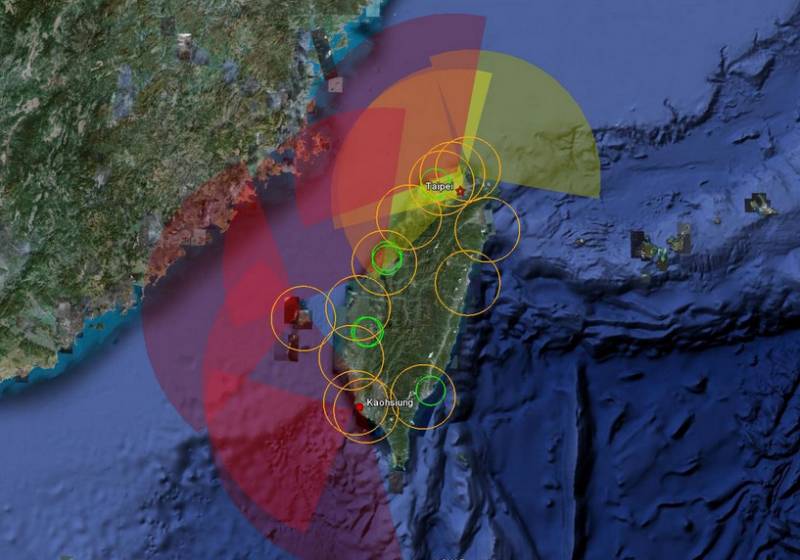
Destruction zones of Taiwanese air defense systems as of 2013. I-HAWK air defense systems are marked in orange, Sparrow air defense systems in green, Patriot air defense systems in yellow, Tien Kung II air defense systems in red
The purpose of creating the next modification of Tien Kung III was to increase anti-missile capabilities and expand the area of destruction of aerodynamic targets. The Tien Kung III anti-aircraft missile is equipped with an active radar homing head with operating frequencies of 12-18 GHz.
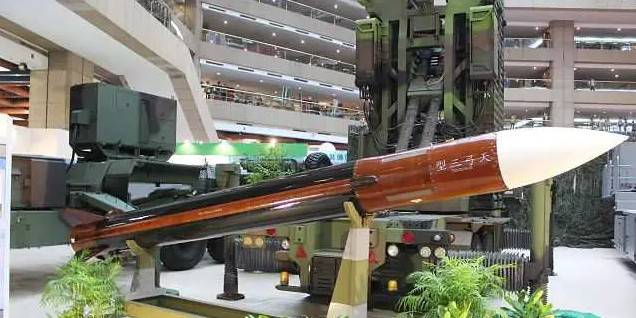
Layout SAM Tien Kung III
For the updated complex, a radar with AFAR, known as Chang Shan, has been developed. This station in a number of technical solutions is similar to the American multifunctional radar AN / MPQ-65 and operates in the 4-8 GHz frequency range. The deployment of the Tien Kung III air defense system began in 2011. Full combat readiness was achieved in 2013.
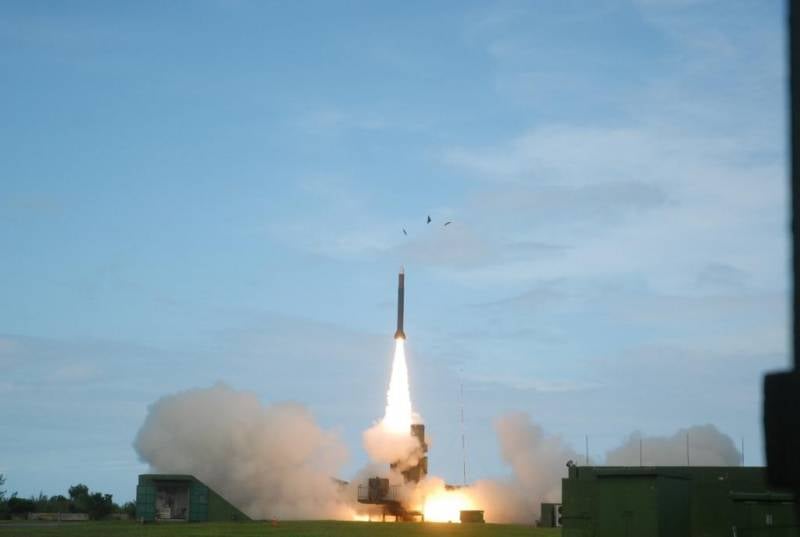
Tien Kung III missile launch
As in the previous model, Tien Kung III missiles are launched from a transport and launch container. There are four TPKs on the launcher. Thanks to the use of a more efficient solid fuel formulation, the characteristics of missiles have improved significantly. The launch weight of the rocket is 880 kg, length - 5,5 m, diameter - 0,4 m. Maximum speed - up to 7M. The firing range for aerodynamic targets is up to 200 km, for ballistic targets - up to 40 km. It is believed that the Tien Kung III air defense system is able to effectively deal with the entire range of aerodynamic targets and operational-tactical ballistic missiles.
At the beginning of 2023, the Strong Bow air defense system was successfully tested, which uses an improved Tien Kung III missile. Western sources claim that the new anti-missile interceptor has an altitude reach of up to 100 km. The main purpose of the Strong Bow complex is to counter the Chinese OTR and IRBM.
To be continued ...
Information